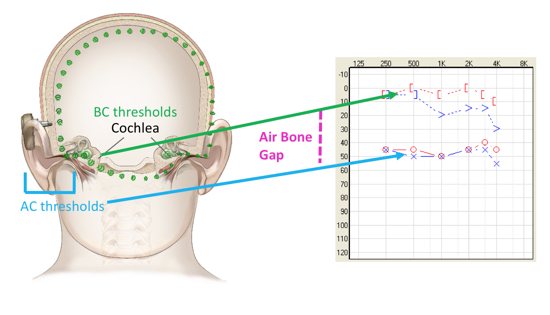Question
How do we determine bone conduction candidacy in children?
Answer
An audiological evaluation and physician consultation is the first step to determining candidacy. Pure tone air and bone conduction testing are the basic measurements used to evaluate the way sound is traveling through the outer, middle and inner ears. Candidates for bone conduction systems have an obstacle somewhere in the outer and/or middle ear that stops airborne sound waves from reaching the inner ear. Something is obstructing the conduction of sound. Very tiny ear canals, often seen in children with Down's syndrome, can contribute to a conductive hearing loss. While the hearing loss is oftentimes in one ear, it can also be a bilateral loss. There are three main audiological indications:
- Conductive hearing loss
- Mixed hearing loss
- Single-sided deafness (SSD)
Conductive hearing losses can be a result of:
- Atresia/Microtia
- Chronic otitis media
- Cholesteatoma
- Middle ear dysfunction/disease
- External otitis
- Cranio-facial Syndromes (e.g. TreacherCollins, Goldenhar, CHARGE)
To be fit with a bone conduction device such as Ponto, bone conduction scores need to be at or better than 65 dB average. In Figure 1 these bone conduction thresholds are quite good falling on average at least 20 dB or better. What I also see here from this audiogram is a very large air bone gap. Air bone gap is just as it states, it's the difference between the air conduction and the bone conduction threshold.

Figure 1. Audiogram of conductive hearing loss.
When sound bypasses the ear canal and middle ear and is detected in the cochlea, hearing is good. The outcome should be very good with bone conduction amplification. This child should hear much better than the way they hear without bone conduction technology. Some children with conductive hearing loss try traditional hearing aids (i.e., air conduction hearing aids), and these children have an ear canal which allows sound to travel through the canal and middle ear to the cochlea. Research suggests if the air bone gap is greater than 30 dB, that speech recognition is likely to be better with a bone anchored hearing device than with a traditional hearing aid. Traditional air conduction hearing aids have to overcome that air bone gap which can lead to excessive whistling, feedback, and a degraded sound quality.
Who are candidates for soft band?
Children under the age of 5, or for those who do not have an implant and abutment. The Bone Anchored Hearing System can be used with a headband. Non-surgical solutions would consist of a band, most often a soft headband and a bone conduction sound processor. However in this scenario, sound passing through the skin dampens the sound vibrations. Children using processors on a band should be using a powerful sound processor because of the sound dampening. Some children will use a bone anchored device for a few years while awaiting reconstructive surgery. Other children might wear this solution while waiting for middle ear problems to subside until they outgrow their ear infections. Or in the case of very tiny ear canals, as you might see in a child with Down's syndrome, oftentimes these children are not able to use traditional hearing aids because their ear canals are too small or are chronically draining or infected. These cases are excellent candidates for a bone conduction device like Ponto on a soft band. As the soft band provides a non-surgical option for children who should eventually grow out of middle ear problems that create a fluctuating conductive hearing loss. The processor will provide the child with consistent access to sound regardless of their fluctuating hearing loss.

Figure 2. Examples of children wearing soft band bone conduction processors.
This Ask the Expert is an excerpt from the CE Course, Unilateral Hearing Loss: Advocating for Children through Early Intervention Services and in the Classroom.


